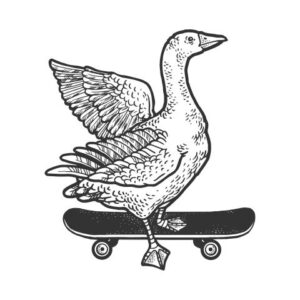Longboarding in the city is a joy to do and is not really hard to do at all. I regularly go longboarding with friends who are in their late 30s and who have never been injured longboarding.
The learning curve with longboarding is not so big and if you want to longboard then there isn’t anything stopping you besides maybe the price tag.
Is It Hard to Learn to Longboard?
Longboarding is inherently difficult as it is a board sport but can be learned relatively quickly by anyone. I regularly take friends out to cruise on a longboard who have no experience. Sometimes they are cruising along in an hour or two and sometimes it takes a few sessions before they get it.
Learning to longboard can be difficult as the sport requires full-body coordination, good balance, and a handful of tricky maneuvers such as stopping the longboard. However, compared to other sports, learning to longboard is relatively quick and easy to do. Most people can learn to cruise in a single afternoon or over the course of a week.
Honestly, I love longboards and you will learn to ride one very quickly even if you aren’t so physically inclined. Some of the people I teach to longboard learn to ride comfortably and never actually fall down in the process. Of course, it helps to be flexible and decently athletic, but I believe anyone can do it.
Below is clip of an old girlfriend that I taught to longboard on her first day. Ignore “웃겨”, which just means “funny” in Korean. “로완” is my name Rowan in Korean script. I’m living abroad and learning the language right now 🙂
Is Skateboarding or Longboarding Harder to Learn?
Skateboarding is harder to learn than a longboard. This is generally true, but some people feel that the smaller skateboard is easier to turn on and control so it’s not absolute.
Skateboards are smaller and harder to control compared to longboards. The average board width of a longboard is much wider than a skateboard and longboards are almost exclusively used for cruising. Skateboards are often used for tricks that can be exceptionally difficult to execute. Most people find that longboarding is easier to learn than skateboarding.
Honestly, you’ll be longboarding very quickly compared to skateboarding and most sports. For longboarding, you just need to be able to stand on your board, push off, turn, stop, and fall correctly and then you’re good to go. Most of that will be learned in an afternoon.
Compare this to skateboarding where people struggle with the most basic tricks like the ollie literally for months. The learning curve for skateboarding is ridiculous and you’ll be riding and having fun on a longboard much quicker.
If you’re curious about how difficult skateboarding really is, check out our guide on why skateboarding is so hard where we present data and stats from real skaters.
Physical Differences Between Skateboards and Longboards
There are actually many differences between skateboards and longboards physically and stylistically in how they are ridden. It’s somewhat like comparing apples and oranges considering that a skateboard is capable of so many diverse tricks and maneuvers that a longboard is simply incapable of doing.
So let’s first look at the physical differences between a longboard and skateboard and then we can discuss the differences in how each one is ridden.
| Characteristic | Skateboards | Longboards |
| Length | Average board length is 28 inches – 32 inches | Average board length is 35 inches – 42 inches, but can be much longer or much shorter |
| Board Width | Average board width is 7.75 inches – 8.25 inches | Average board width is 9 inches – 10 inches |
| Wheels | Small and hard- will easily get wheel bite | Large and soft- won’t easily get wheel bite and will roll over small obstacles. |
| Trucks | Narrow and more rigid trucks that are good for control and grinding | Wider and more flexible trucks that allow carving and a smoother ride |
| Weight | Lighter and easier to carry around | Heavier and bulkier- difficult to transport |
| Board Shape | Classic “popsicle” shape with tail on both ends | Many variations on shape usually with a distinct “tail” and “head” of the board |
Riding Differences Between Skateboards and Longboards
Stylistically skateboarding and longboarding are night and day.
Skateboarding focuses on tricks that vary from street style to vert style. Skateboards are able to cruise, but their hard wheels make it not an appealing option. Usually, skaters switch their wheels to larger longboard wheels if they want to cruise on a classic “popsicle” skateboard deck. There is much more room for creativity and variations on skating styles compared to longboarding.
Longboarding is all about riding or “surfing” the streets. While there are variations in longboarding styles, the longboard is limited in the maneuvers it can physically do. The two most distinct longboarding variants are downhill longboarding and longboard dancing. Usually, a longboard is just used to cruise the streets and boardwalks without performing tricks.
Some people perform longboard tricks, but these people are rather hard to come by compared to a skater who is learning tricks.
Can I Teach Myself to Longboard?
I taught myself to longboard, but I also don’t do downhill longboarding or dance on my longboard. I simply cruise around with friends and explore my city.
You can absolutely teach yourself to longboard with the help of online guides such as those on YouTube. However, I would recommend having someone else with you when you are first learning. Longboarders are at a much higher risk of head injuries than skateboarders and getting a head injury with no one else around could be fatal.
What to Learn First
There are some basics you need to know to get started. This happens before you learn your first trick. These skills are necessary to simply ride around on your board.
1. How to Stand on Your Longboard
Standing on your longboard can be a matter of choice, but there is a popular choice. I recommend the popular choice where your front foot (your non-dominant foot) is placed so your toes are above the front axle. Your back, the dominant foot will push off and come onto the board above the back axle or slightly more forward.
Your front foot will be positioned to face forward or at a 45-degree angle while you push but will transition to being perpendicular to the board direction once both feet are on the board and you’re really moving.
3. How to Stop
The easiest way to stop on a longboard is by dragging your dominant foot flat on the ground. This is actually quite tricky.
To drag your foot you need to have just enough contact to slow down, but not catch your foot and stop abruptly and suddenly. This results in a balancing act as you hang your foot just right off the board so it drags the pavement. You can’t just slam your foot down to stop because at high speeds stopping abruptly can cause injuries.
Make sure you know how to stop before you start going fast. There is no quicker way to hurt yourself than to not know how to stop properly or fall properly.
4. How to Turn
After you can stand on your board, push off, and stop then it’s time to learn to turn. This is relatively easy to learn, but hard to control. You likely have already been turning your board as your balance might not be very good as a beginner.
Turning all comes down to shifting your body weight in the direction you want to turn, and then recentering yourself after the turn. This is the next crucial step in learning to longboard. If you can’t turn, then you can’t ride a longboard.
Shifting your weight can be hard to do for some. You will need to shift your center of gravity just enough to execute the turn and then reposition yourself back to the center of the board.
5. How to Fall
Learning how to fall is critical to your safety while riding a skateboard. The movements needed to fall correctly are natural to some, but not so intuitive to others. The gist is that you want to avoid putting all of the impact of falling onto your joints or appendages. You want to spread the impact of falling across your body.
You need to learn and practice this with repetition. This is because you will fall at some point. Don’t worry about looking ridiculous practicing this. You’re an adult. Safety is more important than looking cool.
Sometimes you won’t always be able to fall correctly.
The most common mistake is the desire to catch yourself with your hands and arms. This is an easy way to get a wrist sprain and potentially break your wrist.
If you are falling down an obstacle or with any forward momentum, then you will want to tuck and roll. This will spread the impact force through your shoulders and back. You can use your hands to help pivot into the tuck and roll, but absolutely do not use them to catch yourself. This will end badly.
If you are falling backward, then you will fall on your butt. Do not try to catch yourself with your arms or hands. Your hands might end up under you as you hit the ground. This will end badly.
Practicing this is easiest to do on a bed or something softer. This is because it is easier to bruise your butt when falling this way.
After learning how to stand, push, stop, turn, and fall properly then you’re ready to go out and cruise your city. So enjoy!~ Now the real fun starts.
If you are just getting started skateboarding or longboarding, check out my guide to skating as an adult with a much-needed reality check.
Can I Teach Myself to Dance on a Longboard?
Teaching yourself to dance on your longboard is the same as teaching yourself any other trick.
You can learn to longboard dance from online guides and trial and error. There are often men and women practicing longboard dance moves on their own in the park. The pitfall with teaching yourself is that it is difficult to objectively see where you are making mistakes. Having an extra person around to video you or give suggestions will help you progress faster.
I have never learned any of these moves because I’ve never really wanted to longboard dance. A simple YouTube search shows loads of longboard dance tutorials even with some in different languages. Maybe I should learn a few and test how long it takes to do so 🙂
Conclusion
So longboarding isn’t really that hard as long as you’re just trying to cruise around. You’ll likely get comfortable riding your board over the course of a week or two, or even in a single afternoon.
Learning tricks will take much longer than learning to cruise, but most longboarders won’t learn tricks anyway. If you do want to learn tricks then YouTube is the place to be. There are tons of great tutorials and it has never been easier to teach yourself to longboard or anything really. The internet is amazing and has revolutionized our access to and ability to share information.
It isn’t really fair to compare skateboards and longboards because the riding styles are so stylistically different.
Anyway, thanks for reading, and look out for more articles from Board and Wheels.



